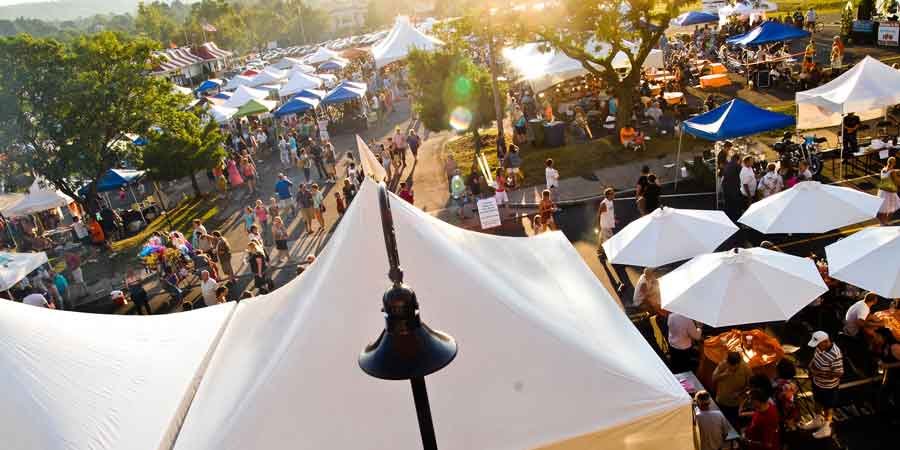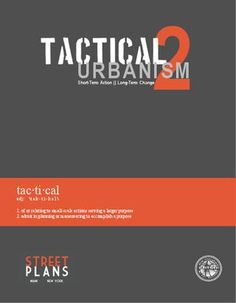
While CSPM Group is managing its crowdsourced placemaking programs within large-scale urban revitalization projects spanning multiple blocks, what can residents do in the immediate term beyond identifying their vision for the future?

Enter tactical urbanism.
Citizens across the country are initiating their own grassroots efforts in improving the livability of their neighborhoods and cities… today… now. From the book, Tactical Urbanism: Short-Term Action, Long-Term Change by The Streets Plan Collaborative, tactical urbanism is defined as:
“Improving the livability of our towns and cities commonly starts at the street, block, or building scale. While larger scale efforts do have their place, incremental, small-scale improvements are increasingly seen as a way to stage more substantial investments. This approach allows a host of local actors to test new concepts before making substantial political and financial commitments. Sometimes sanctioned, sometimes not, these actions are commonly referred to as “guerilla urbanism,” “pop-up urbanism,” “city repair,” or “D.I.Y. urbanism.” While exhibiting several overlapping characteristics, “tactical urbanism,” is a deliberate approach to city-making that features the following five characteristics:
• A deliberate, phased approach to instigating change;
• An offering of local ideas for local planning challenges;
• Short-term commitment and realistic expectations;
• Low-risks, with a possibly a high reward;
• The development of social capital between citizens, and the building of organizational capacity between”
The following ‘tactics’ have been used in CSPM Group projects:
- Pop-Up Retail – Temporary stores in vacant spaces. Communities in Bristol, CT and Huntington Station, NY both hosted shared pop-up retail events, with multiple pop-ups under one roof. Both are advocating for a permanent space for pop-ups, like this space. The goal is to incubate permanent new storefront businesses.
- Pop-Up Plazas – Bristol, CT’s crowdsourced placemaking community, Bristol Rising, hosted not one but two pop-up plaza events, demonstrating what a future piazza could be like for the downtown, attracting record crowds. See image above.
- Park(ing) Day – Crowdsourcing parking spaces into ‘third places’ for a day. The Visualize Nashua community contributed and enjoyed their own Park(ing) Day creation to demonstrate better uses for parking spaces.
- Pop-Up Town Hall – A non-government meeting space to discuss the future of one’s city. Every month, members from each CSPM Group community meet to discuss the future of their downtowns, without fail, and with a positive, often fun vibe. This ain’t your father’s public hearing.
There are myriad other ways CSPM Group communities can work with developers and municipalities to effect incremental change with immediacy, as described and illustrated in the Tactical Urbanism book::
- Site Pre-Vitalization – Temporary activation of a development site, often using shipping containers.
- Open Streets – Massive temporary street closures like Ciclovía and summer street closings in NY, SF. Open Streets Project.
- Play Streets – Repurposing parking lots and streets from car usage to kid usage. Partnership for a Healthier America: Play Streets
- Better Block – A weekend pop-up demonstration of what a main street could be, gone viral. The Better Block.
- Pavement to Plazas – Transforming auto-oriented streets into pedestrian plazas. NYC Plaza Program, Pavement to Plazas initiative.
- Intersection Repair – Transforming neighborhood street intersections into neighborhood squares, mainly via paint and street closures. City Repair: Intersection Repair.
- Guerilla Gardening – Re-purposing underutilized lots for ‘social gardening’. GuerillaGardening.org.
- Pop-Up Parks – Transforming streetside parking spaces into micro parks. Park(ing) Day types of places, but for months. City of San Francisco: Pavement to Parks. City of NY: Street Seats.
- Depave – Green city movement to remove unnecessary paving and replace with green spaces. Depave organization.
- Park-Making – Reclaiming underutilized sites for parks.
- Parkmobiles – Movable landscaped containers that can placed in a standard on-street parking space. Parkmobiles.
- Chair Bombing – Homemade seating in public spaces “to improve comfort, social activity, and sense of place”. DoTank: Chair Bombing.
- Informal Bike Parking – Non-government installed bike racks that are functional indications of where permanent bike parking is needed.
- Ad-Busting – Removing and altering of billboards and large advertising signage. Ad busting on Tumblr.
- Reclaimed Setbacks – Activating front yards to become more community-oriented.
- Weed Bombing – Converting weed overgrowth into landscaped works of art. Weed bombing on Tumblr.
- Food Carts/Trucks – Essentially pop-up cafes on wheels, prevalent in most every major city.
- Mobile Vendors – Aka street vendors, and including bicycle vendors.
- Micro-Mixing – Mixing multiple businesses in a single retail space, like a cafe, bar, bookstore, theater: Cooltown article.
- Camps – Temporary occupying of space with intention of social change (i.e. Occupy movement), disaster relief, or experimentation/prototyping (Burning Man).